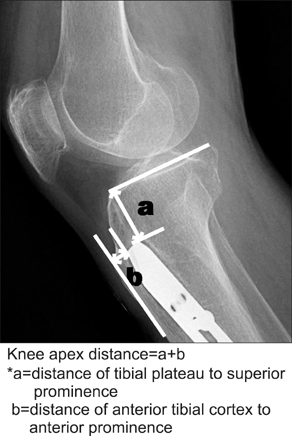J Korean Orthop Assoc.
2009 Feb;44(1):61-67. 10.4055/jkoa.2009.44.1.61.
Anterior Knee Pain after Intramedullary Tibial Nailing
- Affiliations
-
- 1Department of Orthopaedic Surgery, Dong-Eui Medical Center, Busan, Korea.
- 2Department of Orthopaedic Surgery, College of Medicine, Dong-A University, Busan, Korea. libi33@dau.ac.kr
- KMID: 2186379
- DOI: http://doi.org/10.4055/jkoa.2009.44.1.61
Abstract
-
PURPOSE: To document the incidence and analyze the causes of anterior knee pain following closed intramedullary nailing for tibial fractures.
MATERIALS AND METHODS
Between January 2005 and February 2007, 50 tibial fractures (48 patients) were treated using locked intramedullary nails. We examined the relationship between postoperative anterior knee pain and age, gender distribution, mechanism of injury, cause and type of fracture, method of patellar tendon incision, and position of the nails on radiography. Anterior knee pain was assessed using a visual analogue scale (VAS). Pearson chi-square test was used to assess the incidence of knee pain.
RESULTS
At a mean follow-up period of 16 months (range 13-30 months), 23 cases (46%) had developed anterior knee pain. Knee pain was more common in woman (p=0.000), but there was no statistically significant difference with regard to age, cause or type of fracture, reaming or incision technique. If the knee apex distance was below -30 mm on radiological analysis, there was no statistically significant increase in postoperative knee pain (p=0.000). Nail removal resolved or improved the symptoms in 77% of patients with anterior knee pain.
CONCLUSION
Based on these data, nail prominence correlated with increased knee pain. We believe surgeons can decrease the severity of knee pain after tibial nailing by burying the tip of the nail as reflected on lateral radiographs.
MeSH Terms
Figure
Reference
-
1. Alho A, Eke A, Strømsøe K, Follerås G, Thoresen BO. Locked intramedullay nailing for displaced tibial shaft fractures. J Bone Joint Surg Br. 1990. 72:805–809.2. Bhattacharyya T, Seng K, Nassif NA, Freedman I. Knee pain after tibial nailing: the role of nail prominence. Clin Orthop Relat Res. 2006. 449:303–307.3. Bone LB, Kassman S, Stegemann P, France J. Prospective study of union rate of open tibial fractures with locked unreamed intramedullary nails. J Orthop Trauma. 1994. 8:45–49.4. Court-Brown CM, Christie J, McQueen MM. Closed intramedullary tibial nailing. Its use in closed and type 1 open fractures. J Bone Joint Surg Br. 1990. 72:605–611.5. Court-Brown CM, Gustilo T, Shaw AD. Knee pain after intramedullary tibial nailing: its incidence, etiology, and outcome. J Orthop Trauma. 1997. 11:103–105.
Article6. Court-Brown CM, McQueen MM, Quaba AA, Christie J. Locked intramedullary nailing of open tibial fractures. J Bone Joint Surg Br. 1991. 73:959–964.
Article7. Hooper GJ, Keddell RG, Penny ID. Conservative management or closed nailing for tibial shaft fractures. A randomised prospective trial. J Bone Joint Surg Br. 1991. 73:83–85.
Article8. Johner R, Wruhs O. Classification of tibial shaft fractures and correlation with results after rigid interal fixation. Clin Orthop Relat Res. 1983. 178:7–25.9. Keaing JF, O'Brien PJ, Brachut PA, Meek RN, Broekhuyse HM. Locking intramedullary nailing with and without reaming for open fractures of the tibial shaft. A prospective, randomized study. J Bone Joint Surg Am. 1997. 79:334–341.10. Keating JF, Orfaly R, O'Brien PJ. Knee pain after tibial nailing. J Orthop Trauma. 1997. 11:10–13.
Article11. Koval KJ, Clapper MF, Brumback RJ. Complications of reamed intramedullary nailing of the tibia. J Orthop Trauma. 1991. 5:184–189.
Article12. Sanders R, Jersinovich I, Anglen J, Dipasquale T, Herscovici D Jr. The treatment of open tibial shaft fractures using an interlocked intramedullary nail without reaming. J Orthop Trauma. 1994. 8:504–510.
Article13. Shon SK, Kim KT, Cho KW. Anterior knee pain after tibia intramedullary nailing. J Korean Fracture Soc. 1998. 10:109–113.14. Toivanen JA, Väistö O, Kannus P, Latvala K, Honkonen SE, Järvinen MJ. Anterior knee pain after intramedullary nailing of fractures of the tibial shaft. A prospective, randomized study comparing two different nail-insertion techniques. J Bone Joint Surg Am. 2002. 84:580–585.15. Waston JT. Treatment of unstable fractures of the shaft of the tibia. J Bone Joint Surg Am. 1994. 76:1575–1584.16. Whittle AP, Russell TA, Taylor JC, Lavelle DG. Treatment of open fractures of the tibial shaft with the use of interlocking nailing without reaming. J Bone Joint Surg Am. 1992. 74:1162–1171.
Article17. Wiesenfeld-Hallin Z. Sex differences in pain perception. Gend Med. 2005. 2:137–145.
Article
- Full Text Links
- Actions
-
Cited
- CITED
-
- Close
- Share
- Similar articles
-
- Anterior Knee Pain after Intramedullary Nailing for Tibial Shaft Fractures
- Knee Pain Analysis After Tibia Intramedullary Nailing
- The Clinical Results of Unreamed Interlocking Intramedullary Nailing for Tibial Fractures
- Pseudoaneurysm of the Anterior Tibial Artery After Closed Intramedullary Nailing of a Tibial Shaft Fracture: A Case Report
- Anterior Knee Pain after Tibia Intramedullary Nailing



